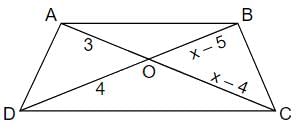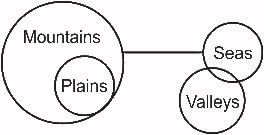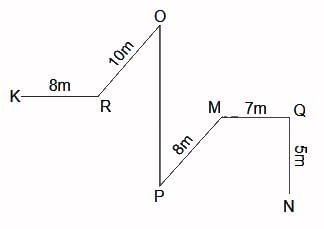Maths & Logical Reasoning Test - 4 - SSC CGL MCQ
30 Questions MCQ Test SSC CGL Tier II Mock Test Series 2025 - Maths & Logical Reasoning Test - 4
The angle of elevation of the tower at a point on level of ground is 15°. When moved 50√3 m towards the tower, the angle of elevation becomes 75°. What is the height (in m) of the tower?
Station A is 530 km away from station B. A train starts from Station A at 9:00 A.M. towards Station B at 90 km/h, while another train starts from Station B at 10:00 A.M. towards Station A at 90 km/h. At what time do they meet?
If θ is acute angle and cos2 θ − sin2 θ = −1/2; then the value of [cos22θ + cot2 (θ/2)] is:
The ratio of 3 years of C.I. and S.I. of one year on a certain sum of money is 4.75 ∶ 1. Find rate percent?
The ratio of boys and girls in a class is 5 : 14 respectively. The average score of the class is 142.5 and that of boys is 246.1, what is the average score of girls?
To cover a distance of 504 km, train B takes 12/5 hours more than train A. If the speed of Train B is doubled, it would take 4(4/5) hours less than A. What is the speed (in km/h) of A?
P and Q are two mixtures of milk and water and they are mixed in the ratio of 5 ꓽ 6 respectively by volume. After then, mixture Q alone is added to the resulting mixture in such a way that the volume of the resulting mixture will become double and contain 72% milk. If mixture Q has 77% milk, what is the percentage of milk in mixture P?
In the given figure, AB || CD || PQ, AB = 24 cm, CD = 32 cm and AC = 21 cm, what is the length (in cm) of PQ?

A coin is thrown 5 times. What is the probability that at least one head obtained?
ABCD is a trapezium with AB || CD and AB < CD. AC and BD intersect each other at point O. If AO = 3 cm, OC = (x – 4) cm, BO = (x – 5), and OD = 4 cm, find the value of x.
Three Statements are given followed by Three conclusions numbered I, II and III. Assuming the statements to be true, even if they seem to be at variance with commonly known facts, decide which of the conclusions logically follow(s) from the statements.
Statements:
All plains are mountains.
No sea is a mountain.
Some valleys are seas.
Conclusions:
I. Some valleys are plains.
II. No valley is a mountain.
III. No sea is a plain.
If ‘+’ means ‘÷’, ‘ ̶ ’ means ‘+’, ‘×’ means ‘−’ and ‘÷’ means ‘×’, what will be the value of the following expression?
[{( 14 × 6 ) - ( 4 ÷ 3 )} + ( 6 - 4 )] ÷ 3
Eight houses P, Q, R, S, T, U, V, and W are in two rows with four houses in each row. But not necessarily in the same order.
1) R is facing U.
2) V and P are diagonally opposite and V is facing south.
3) T is facing W but is not in the same row as that of P.
4) W is between S and R.
Which house is facing Q?
Study the given pattern carefully and select the number that can replace the question mark (?) in it.
First row: 32, 51, 33
Second row: 28, 33, 25
Third row: 16, 27, ?
(NOTE: Operations should be performed on the whole numbers, without breaking down the number into its constituent digits. For example, 13 – Operations on 13 such as adding/deleting/multiplying etc. to 13 can be performed. Breaking down 13 into 1 and 3 and then performing mathematical operations on 1 and 3 is not allowed.)
Directions: In the question below, a statement and assumptions numbered I and II are given. An assumption is something supposed or taken for granted. You have to consider the following assumption and decide which of the assumption is implicit in the statement.
Statement: Conventional methods of teaching faced a challenge during the Pandemic.
Assumption:
I. Conventional methods of teaching are unfit for the modern age.
II. The teaching system was not robust.
In this question, three statements are given, followed by two conclusions numbered I and II. Assuming the statements to be true, even if they seem to be at variance with commonly known facts, decide which of the conclusions logically follows/follow from the statements.
Statements:
All bottles are bags.
Some bags are pencils.
Some pencils are sharpeners.
Conclusions:
I. Some sharpeners are bottles.
II. Some bottles are pencils.
In this question, the statement is followed by two conclusions. Which of the two conclusions is/are true?
Statement: X < U = F > R ≥ P < T < W
Conclusions:
I. X < T
II. R > W
Directions: A mirror is placed on the line MN, and then which of the answer figures is the right image of the given question figure?

What is the direction of point N with respect to point R?
In a certain code language, 'KEYBOARD' is written as 'BVPDQWIZ'. How will 'BIRTHDAY' be written in that language?
The figure given in the question is folded to form a box. Choose from four alternatives, the boxes that are similar to the box formed .


Directions: To each of the following questions, four probable answers have been given as alternatives. Select the most appropriate alternative as the answer.
Recently a new neighbor has shifted next to your house and disposes of waste outside your home.
If * means division, $ means addition, % means multiplication, & means subtraction, and # means equals to, then in the equation below which two signs must be interchanged to correct the equation?
18 $ 36 * 108 % 24 & 7 # 23
Directions : In question, some statements are given, followed by two conclusions I and II. You have to consider the statements to be true, even if they seem to be at variance from commonly known facts. You have to decide which of the given conclusions, if any, follow from the given statements. Indicate your answer.
Statements:
Only a few Cat is Dog
All Black is White
Few Dog is Black
Conclusions:
I. Some White is Cat
II. Some Cat is not Black
Directions: What will come in place of question mark (?) in the following series?
18, 40, 84, 172, 348, ?
|
66 docs|139 tests
|








 = 1700
= 1700 = 170000
= 170000


 )
)



























.svg)













